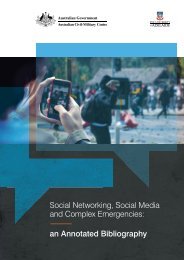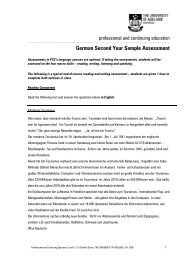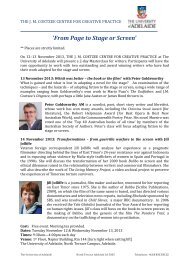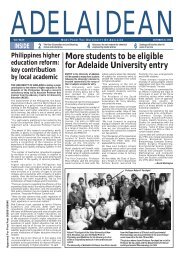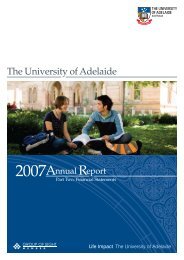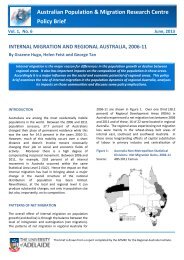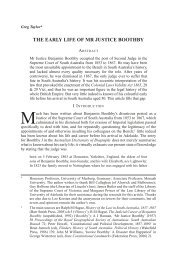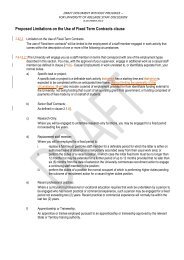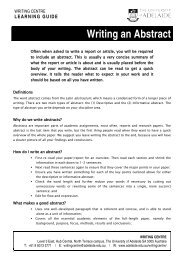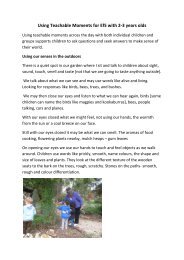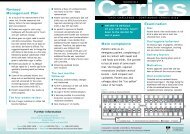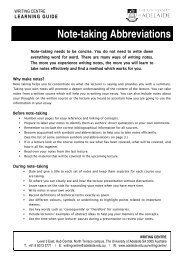Unbridling the Tongues of Women - The University of Adelaide
Unbridling the Tongues of Women - The University of Adelaide
Unbridling the Tongues of Women - The University of Adelaide
You also want an ePaper? Increase the reach of your titles
YUMPU automatically turns print PDFs into web optimized ePapers that Google loves.
<strong>The</strong> line <strong>of</strong> least resistance<br />
Jane Melville (Mr Hogarth’s Will) and Liliard Abercrombie (Handfasted) are far<br />
less conventional at <strong>the</strong> opening <strong>of</strong> <strong>the</strong>ir stories. Jane has been given an education like<br />
that <strong>of</strong> a man, and <strong>the</strong>n cast into <strong>the</strong> world to make a living. Her conversation with<br />
Mr Rennie, who will not give her a job because she is a woman, is an explicit statement<br />
<strong>of</strong> outrage at a gender-divided labour market. 70 She finally secures employment<br />
as a governess-cum-housekeeper in <strong>the</strong> household <strong>of</strong> some Australians visiting <strong>the</strong>ir<br />
homeland, and, like Margaret Elliot, seeks to influence <strong>the</strong> wider world indirectly.<br />
Margaret hopes to work with, and through, her bro<strong>the</strong>r; Jane works with <strong>the</strong> male<br />
cousin whom, once he has shed his inheritance, she marries. Liliard Abercrombie was<br />
bound to be unconventional since she had grown up in an Arcadian society, separated<br />
from <strong>the</strong> rest <strong>of</strong> <strong>the</strong> world for three generations. But she is unconventional in<br />
Columba, too. She aspires to a degree <strong>of</strong> learning and public usefulness reserved for<br />
a social group to which she does not belong. She is imaginative, spontaneous, and –<br />
aided by <strong>the</strong> odd garments into which she has knitted stories she has heard told – she<br />
is an emotionally powerful public speaker, an ability <strong>of</strong> distinction in an oral culture. 71<br />
She is also independent, insisting upon <strong>the</strong> legitimacy <strong>of</strong> <strong>the</strong> bond she forms with <strong>the</strong><br />
hero in Columba, even when <strong>the</strong>y leave that hidden valley and enter a world which<br />
regards <strong>the</strong>ir union as wholly unsanctified. Only after suffering her apparent loss <strong>of</strong><br />
reputation, and a disfiguring attack <strong>of</strong> smallpox, does she dwindle into a wife.<br />
Spence’s heroines may be less unconventional than <strong>the</strong>y appear at first sight.<br />
Clara Morison asks Reginald, during one <strong>of</strong> <strong>the</strong>ir literary discussions, ‘Is not Jane<br />
Eyre, who is nei<strong>the</strong>r handsome nor what is called good, a much more interesting<br />
and natural character than you will find in men’s books?’ 72 Margaret Oliphant noted<br />
as early as 1855 that Jane Eyre had changed <strong>the</strong> direction <strong>of</strong> <strong>the</strong> female tradition in<br />
English writing, and Elaine Showalter observed over a century later: ‘<strong>The</strong> influence<br />
<strong>of</strong> Jane Eyre on Victorian heroines was felt to have been revolutionary. <strong>The</strong> post-Jane<br />
heroine, according to <strong>the</strong> periodicals, was plain, rebellious, and passionate; she was<br />
likely to be a governess, and she was usually <strong>the</strong> narrator <strong>of</strong> her own story’. 73 Spence’s<br />
heroines are not sexually passionate, nor do <strong>the</strong>y narrate <strong>the</strong>ir own stories. But <strong>the</strong>y<br />
are <strong>of</strong>ten plain, <strong>of</strong>ten governesses, sometimes passionate about public affairs, and<br />
always – however mildly – rebellious. Moreover <strong>the</strong>y inhabit worlds in which <strong>the</strong>re<br />
are o<strong>the</strong>r remarkable women: Margaret Elliot, a blue-stocking; Rose Lancaster, an<br />
intellectual; <strong>the</strong> independent-minded Mrs Lindsay, and her daughter, Jessie, who<br />
proposes to <strong>the</strong> man she loves on her way to do <strong>the</strong> milking. All <strong>of</strong> <strong>the</strong>se characters<br />
are most unconventional when compared with Thackeray’s schemers or Dickens’ in-<br />
59



